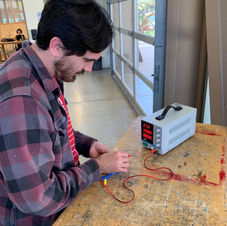Process Updates (4/23/24)
So far, we have been in contact with all of our partners and community liaisons. Our contacts with the Navajo Nation communicated a need for cheaper DC solar systems and better refrigeration technology. To begin our design and experiment process, we ordered $20 Peltier cooling unit from Amazon and ran some tests.


We prepared the Peltier unit's wires for solar panel attachment.

We connected the unit to the solar panel and prepared to operate the cooling unit on a partly sunny day.

The Peltier's fan started spinning, producing mildly cool air and significantly cooling the aluminum. The test was a success!

The unit ran steadily at 18 volts for over an hour, generating ~100 watts.



Process Updates (4/30/24)
After running some successful tests on our Peltier unit from Amazon, we used a data logger to test temperature, indicating the extent of the unit's cooling effect.
Cooling Tests
Spot welding
DC configuration
Preparation of insolation materials
Cutting Styrofoam insolation to fit cooling unit
Placement of cooling unit within the insolation (surrounded with tape)
Configure wires to test different temperature points
Leave outside to collect temperature data!
Freezing temperatures! Test was a success
Process Updates (5/7)
After conducting some cooling tests indicating an ability to cool to freezing temperatures, we decided to order 5 additional Peltier plate modules from Amazon. We plan to run some test on these next week. Today, we acquired two Peltier plates from the lab, and we ran some tests. Our focus was to put multiple plates together and measure any temperature changes.

Peltier plates ordered from Amazon
Peltier plates acquired from the lab. We want to put them together and run temperature tests.
We used a clamp to attach three plates together, testing which sides get hot and cool (if at at all).
We measured 5.4 amps. The plates significantly cooled and heated, depending on the sides.
Process Updates (5/14)
At the end of our previous shop section, we had some discussions within the group and consulted Pete regarding our project's next steps. We determined that DC refrigeration was beyond the scope of the remaining weeks of this class. Pete advised us to go in the direction of DC solar lights. Today during shop, we ran some tests on a solar charge controller, determining the efficacy of powering small-scale lighting systems.

Lithium ion batteries combined with duck tape
Batteries were successfully charged! The system powered a small fan we attached
System charged Sebastian's phone












